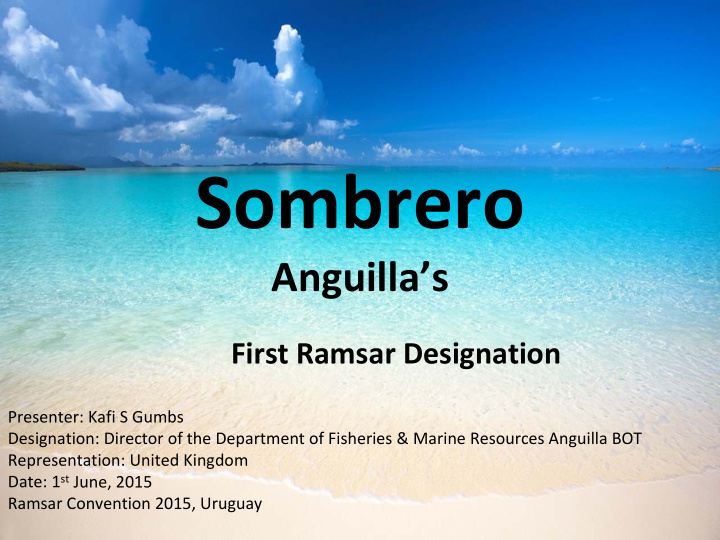



Sombrero Anguilla’s First Ramsar Designation Presenter: Kafi S Gumbs Designation: Director of the Department of Fisheries & Marine Resources Anguilla BOT Representation: United Kingdom Date: 1 st June, 2015 Ramsar Convention 2015, Uruguay
Where in the world is Anguilla? • Located: 18°N, 63°W • Widest point 3 miles (5 km) • In the Caribbean • 35 square miles (90 km²) • Forms part of the Lesser Antilles • The island's capital is The Valley • Most northern of the Leeward Islands • Human population 13,500 • East of Puerto Rico & the Virgin Islands • Main economy is tourism • Directly north of Saint Martin • Language spoken is English • Anguilla is the mainland • Currency used is the EC & USD • Surrounded by 8 small uninhabited cays • Parliamentary dependency under • Anguilla is 16 miles (26 km) long a constitutional monarchy
Historical Overview • First settled by the Amerindians. Artefacts dating back to 1300BC • Columbus discovered them in ~1493 named it Anguilla(Eel)? • French explorer Pierre Laudonnaire in 1565 named it Anguilla(Eel)? • Settled by the British in 1650. Administered out of Antigua • Federation of Anguilla, St. Kitts, Nevis • No plantation slavery due to low rainfall & infertile soil • 1967 Anguilla Revolution against going independent with St. Kitts. Anguilla remains BOT
Introduction to Sombrero
Ecological significance of Sombrero • Coral reef ecosystems • Excellent fish habitats.migratory species pelagics, turtles, mammals • Five nesting bird species e.g Brown Booby ( Sula leucogaster ), Brown Noddy ( Anous stolidus ), Soothy Tern ( Onychoprion fuscatus ), Briddled Tern ( Onychoprion anaethetus ), Masked Booby ( Sula dactylatra ) (Spoede 1999 & Mukhida 2015) • 900 pairs of nesting sea birds on Sombrero (Spoede 1999) • Bridled Tern 222 nesting pairs (Mukhida 2015) • Black Lizard ( Ameiva corvina ) • Endemic species listed as vulnerable under the IUCN Redlist
Ecological significance of Sombrero
Sombrero Today • Used for fishing, esp. sport fishing • Bird habitat • Bird watchers and researchers haven
Ramsar in Anguilla
Ramsar in Anguilla • Established in 1971 in Ramsar, Iran • Extended to Anguilla in 1991 • 41 Ramsar sites designated across 20 Caribbean countries • March 2014, Ramsar Secretariat gave the ANT in collaboration with the DFMR, DOE & the RSPB US$30,000.00 for wetland conservation work in Anguilla
Ramsar in Anguilla • ANT 1 year project to collect and analyse local wetland wild life data & develop a framework to guide conservation action for the wetlands policy • December 2014, ANT & RSPB stakeholder workshop to discuss potential local Ramsar sites • March 2015 ANT, DOE, DFMR, RSPB presented Sombrero to ExCo as Anguillas first potential Ramsar site
Wetlands of Anguilla • Salt ponds & mangrove forests • Cave systems • Seagrass beds • Sand dunes, bays & sandy beaches, • Coral reefs • Rocky marine shores • Islands
Why Sombrero? • Sombrero Island is owned by the crown • Complement Memory of the World nomination • Already protected (land & water) through the Marine Parks Act • Very little GOA investment required • Protect it from harmful developments e.g. Beal Aerospace (Spoede 1999)
Why Sombrero? • Sombrero fulfils Ramsar criteria i, ii, iii, iv, & vi • Rare/unique examples of rear natural wetland types: coral, rocky, marine shores (rock cliffs), karst & other subterranean hydrological systems (human-made & marine/coastal) • Regionally typical species - seabirds & reptiles • Nationally protected (land & water) through the Biodiversity & Heritage Conservation Act (2009)
Benefits of the designation to Anguilla • Fulfillment of an important MEA obligation • Increase international awareness about & respect for Anguilla • Access to a vast array of technical expertise • Access to Ramsar Secretariat funding • Increase Anguilla’s eco-tourism potential and potential economic earnings • New tourism venture
The way forward& next step
Benefits of Anguilla Wetlands • Resources provisioning e.g. water through groundwater replenishment, fish & plants with medicinal properties • Nursery & refuge for fish, birds & other animals • Source for fish stocks • Recreational use for locals & tourists • Preserve historical & cultural artifacts & practices e.g. salt harvesting, fishing & pond boat racing
Benefits of Anguilla Wetlands • Stabilize & protect shoreline during storms • Help to prevent flooding • A natural function that has been estimated to save the Anguillian Government XCD $3m annually (Homer, 2005) • Assist with pest control • Provide Anguilla with potential for international recognition which could be used to explore new tourism markets through wetlands- & eco- tourism development
Thank you…Questions?
Anguilla National Trust Dept. of Fisheries & Marine Resources P.O. Box 1234 Government of Anguilla The Valley The Valley AI ‐ 2640 Anguilla ANGUILLA British West Indies AI ‐ 2640 Tel: (264) ‐ 497 ‐ 2871 / 8705 Tel. 264 497 5297 Mobile: (264) ‐ 583 ‐ 7070 Skype. farah.mukhida Fax: (264) ‐ 497 ‐ 8567 Facebook. www.facebook.com/axanationaltrust Email: kafi.gumbs@gov.ai
Recommend
More recommend